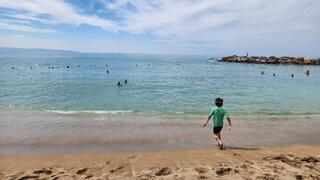While regional attention remains focused on the escalating tensions along Israel’s northern border , Israeli researchers are sounding the alarm over a quieter but potentially hazardous environmental issue unfolding offshore: industrial and pharmaceutical pollution from Lebanon seeping into the Mediterranean Sea. A recent study has detected unusually high concentrations of pollutants along Lebanon’s coastline, including heavy metals such as mercury, lead and cadmium, as well as pharmaceutical residues and plastic-based compounds . These substances, which originate from factories, agricultural runoff, sewage systems and human waste, are accumulating in the marine ecosystem and may pose serious health risks to humans, scientists say.
2 View gallery ( Photo: Gadi Kablo ) “These pollutants do not break down easily,” said Dr. Jack Silverman, a marine pollution researcher at Israel’s National Institute of Oceanography. “They settle on the seabed and gradually make their way into marine organisms, including fish, crabs, shellfish, sharks and sea turtles.

” According to Silverman, studies have found some of the world’s highest concentrations of heavy metals in sharks caught off the Israeli coas t. Sea turtles have also shown elevated mercury levels, particularly in the Western Galilee region. Although Mediterranean currents typically flow from south to north, seasonal transitions can reverse the direction of the flow for extended periods, allowing pollutants to drift southward, Silverman said.
A notable instance was recorded in 1992, when plastic debris believed to be from Lebanon was found washed ashore in Achziv in northern Israel. The study also documented a steady rise in cadmium levels in marine snails along northern Israel’s coast. Unusual mercury concentrations have been detected in nesting sea turtles and marine sponges near Rosh HaNikra.
While the source cannot be definitively linked to Lebanon, researchers say regional contamination is a plausible factor. “There’s a possibility we’re seeing Lebanese influence on the metal concentrations in our waters,” Silverman said. Local and regional pressures on marine systems The pollution threat is compounded by Israel’s own growing environmental challenges.
As the population increases, so does the production of wastewater, placing mounting pressure on the country’s marine systems. “There’s a need to address what we do with our excess treated wastewater,” Silverman said. 2 View gallery The air over Haifa ( Photo: AFP ) Recent data shows worsening pollution trends in northern Israel, with mercury levels in some locations exceeding those found in Haifa Bay—one of Israel’s most heavily industrialized regions.
While local sources could be responsible, Silverman cautions that regional pollution from other areas, such as Egypt’s Nile Delta, may also be contributing. Runoff from the Nile carries contaminants including arsenic and chromium that may reach Israel’s coast via marine currents. In addition, desalination plants in Israel are frequently exposed to sewage from Gaza, Silverman noted.
“This sewage doesn’t just bring heavy metals and pollutants—it also carries bacteria and viruses that can contaminate desalination facilities and beaches, posing a public health risk,” he said. “The systems are currently able to cope, but the question is: at what cost, and for how long?” International efforts and challenges The issue has drawn attention to the need for enhanced regional cooperation. Israel is a signatory to the Barcelona Convention, an international agreement aimed at protecting the Mediterranean Sea and fostering environmental collaboration among its coastal states, including those without diplomatic ties.
Another key agreement, MARPOL, seeks to prevent marine pollution from ships. Despite these frameworks, cross-border coordination remains limited. “It’s not enough for each country to monitor its own waters,” Silverman said.
“We need to work together, share data, and understand the full picture—because the sea doesn’t recognize political boundaries.” Still, there are signs of progress. Last year, Israeli and Cypriot scientists launched a joint marine monitoring project aimed at replicating Israel’s national marine tracking system.
The initiative seeks to assess the long-term effects of human activity on the sea and monitor environmental changes. Dialogue is also taking place under the auspices of the United Nations Environment Programme (UNEP), which brings together Mediterranean countries, including Israel, Egypt, Morocco, Libya—and, at times, Lebanon—for discussions on joint marine policies. Silverman recalled attending one such meeting where delegates from the region gathered to explore avenues for cooperation.
“There is a growing awareness that the health of the sea concerns us all,” Silverman said. “What affects the north can easily make its way south. There are many people who care deeply about the environment, and it’s up to us to act.
” Get the Ynetnews app on your smartphone: Google Play : https://bit.ly/4eJ37pE | Apple App Store : https://bit.ly/3ZL7iNv Despite regional turmoil and political divisions, environmental cooperation offers a rare opportunity for dialogue and shared progress.
“The Mediterranean is a common space,” Silverman added. “If we work together to protect it, we can secure a vital, life-sustaining resource for ourselves and for future generations.” This report was produced in collaboration with ZAVIT – the news agency of the Israel Society of Ecology and Environmental Sciences.
>.
Environment

Pollution from Lebanon poses growing risk to Israel's shore, researchers warn

Recent study detects unusually high concentrations of pollutants along Lebanese coastline, including heavy metals such as mercury, lead and cadmium, as well as pharmaceutical residues and plastic-based compounds














